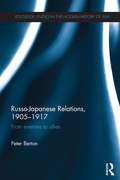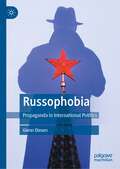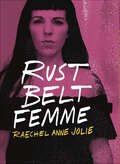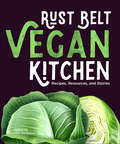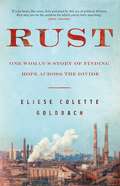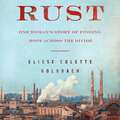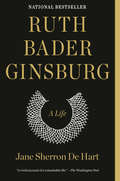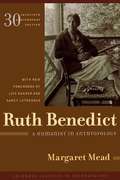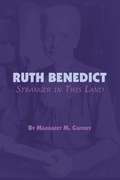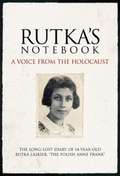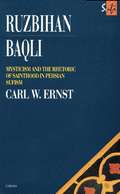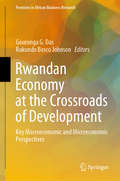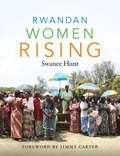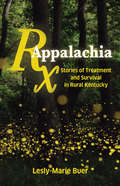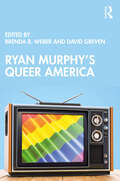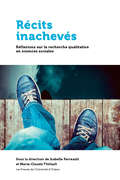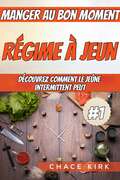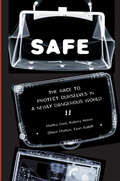- Table View
- List View
Russo-Japanese Relations, 1905-17: From enemies to allies (Routledge Studies in the Modern History of Asia)
by Peter BertonOne surprising outcome of the Russo-Japanese War of 1904–1905 was that, although Russia was humiliatingly defeated, by 1916 Russia and Japan had become allies. This book provides a detailed analysis of how this remarkable turnaround came about. It traces the evolution of relations between the two powers through the conclusion of three public and secret agreements in 1907, 1910, and 1912, and the controversial secret alliance of 1916. The book argues that careful examination of complete records of negotiations from both sides definitively proves the case for Germany, not the United States, as the target of the secret treaty. Based on meticulous examination of documents in both Russian and Japanese foreign policy archives, it charts diplomatic developments, explores how Japanese and Russian thinking evolved, and assesses the wider international impact of the new alliance.
Russophobia: Propaganda in International Politics
by Glenn DiesenThis book defines Russophobia as the irrational fear of Russia, a key theme in the study of propaganda in the West as Russia has throughout history been assigned a diametrically opposite identity as the “Other.” Propaganda is the science of convincing an audience without appealing to reason. The West and Russia have been juxtaposed as Western versus Eastern, European versus Asiatic, civilized versus barbaric, modern versus backward, liberal versus autocratic, and even good versus evil. During the Cold War, ideological dividing lines fell naturally by casting the debate as capitalism versus communism, democracy versus totalitarianism, and Christianity versus atheism. After the Cold War, anti-Russian propaganda aims to filter all political questions through the simplistic binary stereotype of democracy versus authoritarianism, which provides little if any heuristic value to understand the complexities of relations. A key feature of propaganda against the inferior “Other” is both contemptuous derision and panic-stricken fear of the threat to civilization. Russia has therefore throughout history been allowed to play one of two roles—either an apprentice of Western civilization by accepting the subordinate role as the student and political object, or a threat that must be contained or defeated. While propaganda has the positive effect of promoting unity and mobilizing resources toward rational and strategic objectives, it can also have the negative effect of creating irrational decision-making and obstructing a workable peace.
Rust Belt Femme
by Raechel Anne JolieAn NPR Best Book: &“[Jolie's] story is both remarkable and utterly ordinary; any dreamy kid who grew up broke and weird will see a spark of themselves.&” ―The New Republic One of NPR&’s Best Books of 2020 Winner, Independent Publisher Awards Gold Medal for LGBTQ+ nonfiction Raechel Anne Jolie&’s early life in a working-class Cleveland exurb was full of race cars, Budweiser-drinking men covered in car grease, and the women who loved them. After her father came home from his third-shift job, took the garbage out to the curb and was hit by a drunk driver, her life changed. Raechel and her mother struggled for money: they were evicted, went days without utilities, and took their trauma out on one another. Raechel escaped to the progressive suburbs of Cleveland Heights, leaving the tractors and ranch-style homes in favor of a city with vintage marquees, music clubs, and people who talked about big ideas. It was the early &’90s, full of Nirvana songs and chokers, flannel shirts and cut-off jean shorts, lesbian witches and local coffee shops. Rust Belt Femme is the story of how these twin foundations―rural Ohio poverty and alternative &’90s culture―made Raechel into who she is today: a queer femme with PTSD and a deep love of the Midwest. &“A sharp coming-of-age portrait.&” ―Kirkus Reviews &“This miraculous little book manages to plumb the depths of poverty, trauma, punk rock, maternal devotion, young love, and queer identity in language that is lyric and precise. I was blown away. You will be too.&” —Steve Almond, New York Times–bestselling author of Truth is the Arrow, Mercy is the Bow
Rust Belt Vegan Kitchen: Recipes, Resources, and Stories
by Belt PublishingA varied, handy collection of Rust Belt culinary favorites, updated for today&’s vegan diet. The Rust Belt Vegan Kitchen is a community cookbook created by professional and home chefs who live and work in the Rust Belt. Recipes collected here represent the diversity of the region, and include vegan versions of:Polish pierogisDetroit coney dogsHungarian paprikashSlovak kolachesMexican conchasGerman sauerkraut ballsCincinnati chiliSlovenian fish fryChitterings, and many more.The cooks and chefs collected here offer stories about their recipes as well as family and culinary traditions. The book also includes resources on how to stock a vegan pantry, guides to useful equipment, and basic how-tos for &“veganizing&” staples. Infusing old world recipes with a new level of creativity for a changing audience, The Rust Belt Vegan Kitchen is unpretentious, accessible, and fun.
Rust: One woman's story of finding hope across the divide
by Eliese Colette Goldbach''[a] memoir of modern American industrial life, written by the insider who got away - or got away enough to reflect intelligently on where they came from. Think JD Vance's Hillbilly Elegy and even Tara Westover's Educated . . . We could all learn from her example.' New York Times Book ReviewEliese wasn't supposed to be a steelworker. Raised by staunchly Republican and Catholic parents, Eliese dreamed of escaping Cleveland and achieving greatness in the convent as a nun. Full of promise and burgeoning ideals, she leaves her hometown, but one night her life's course is violently altered. A night that sets her mind reeling and her dreams waning. A cycle of mania and depression sinks in where once there were miracles and prayers, and upon returning home she is diagnosed with mixed-state bipolar disorder.Set on a path she doesn't recognize as her own, Eliese finds herself under the orange flame of Cleveland's notorious steel mill, applying for a job that could be her ticket to regaining stability and salvation. In Rust, Eliese invites the reader inside the belly of the mill. Steel is the only thing that shines amid the molten iron, towering cranes, and churning mills. Dust settles on everything - on forklifts and hard hats, on men with forgotten hopes and lives cut short by harsh working conditions, on a dismissed blue-collar living and on what's left of the American dream.But Eliese discovers solace in the tumultuous world of steel, unearthing a love and a need for her hometown she didn't know existed. This is the story of the humanity Eliese finds in the most unlikely of places and the wisdom that comes from the very things we try to run away from most. A reclamation of roots, Rust is a shining debut memoir of grit and tenacity and the hope that therefore begins to grow.
Rust: One woman's story of finding hope across the divide
by Eliese Colette GoldbachELIESE WASN'T SUPPOSED TO BE A STEELWORKER.Raised by staunchly Republican and Catholic parents, Eliese dreamed of escaping Cleveland and achieving greatness in the convent as a nun. Full of promise and burgeoning ideals, she leaves her hometown, but one night her life's course is violently altered. A night that sets her mind reeling and her dreams waning. A cycle of mania and depression sinks in where once there were miracles and prayers, and upon returning home she is diagnosed with mixed-state bipolar disorder.Set on a path she doesn't recognize as her own, Eliese finds herself under the orange flame of Cleveland's notorious steel mill, applying for a job that could be her ticket to regaining stability and salvation. In Rust, Eliese invites the reader inside the belly of the mill. Steel is the only thing that shines amid the molten iron, towering cranes, and churning mills. Dust settles on everything - on forklifts and hard hats, on men with forgotten hopes and lives cut short by harsh working conditions, on a dismissed blue-collar living and on what's left of the American dream.But Eliese discovers solace in the tumultuous world of steel, unearthing a love and a need for her hometown she didn't know existed. This is the story of the humanity Eliese finds in the most unlikely of places and the wisdom that comes from the very things we try to run away from most. A reclamation of roots, Rust is a shining debut memoir of grit and tenacity and the hope that therefore begins to grow.(P)2020 Macmillan Audio
Ruth Bader Ginsburg: A Life
by Jane Sherron de HartThe first full life—private, public, legal, philosophical—of the 107th Supreme Court Justice, one of the most profound and profoundly transformative legal minds of our time; a book fifteen years in work, written with the cooperation of Ruth Bader Ginsburg herself and based on many interviews with the justice, her husband, her children, her friends, and her associates. <P><P>In this large, comprehensive, revelatory biography, Jane De Hart explores the central experiences that crucially shaped Ginsburg’s passion for justice, her advocacy for gender equality, her meticulous jurisprudence: her desire to make We the People more united and our union more perfect. At the heart of her story and abiding beliefs—her Jewish background. Tikkun olam, the Hebrew injunction to “repair the world,” with its profound meaning for a young girl who grew up during the Holocaust and World War II. We see the influence of her mother, Celia Amster Bader, whose intellect inspired her daughter’s feminism, insisting that Ruth become independent, as she witnessed her mother coping with terminal cervical cancer (Celia died the day before Ruth, at seventeen, graduated from high school). <P><P> From Ruth’s days as a baton twirler at Brooklyn’s James Madison High School, to Cornell University, Harvard and Columbia Law Schools (first in her class), to being a law professor at Rutgers University (one of the few women in the field and fighting pay discrimination), hiding her second pregnancy so as not to risk losing her job; founding the Women's Rights Law Reporter, writing the brief for the first case that persuaded the Supreme Court to strike down a sex-discriminatory state law, then at Columbia (the law school’s first tenured female professor); becoming the director of the women’s rights project of the ACLU, persuading the Supreme Court in a series of decisions to ban laws that denied women full citizenship status with men. <P><P> Her years on the U.S. Court of Appeals for the District of Columbia Circuit, deciding cases the way she played golf, as she, left-handed, played with right-handed clubs—aiming left, swinging right, hitting down the middle. Her years on the Supreme Court . . . A pioneering life and legal career whose profound mark on American jurisprudence, on American society, on our American character and spirit, will reverberate deep into the twenty-first century and beyond.
Ruth Benedict: A Humanist in Anthropology
by Margaret MeadMargaret Mead offers a deeply insightful portrait of a woman who overcame the barriers of sexism to become one of the most compelling intellectual figures in twentieth-century American life.
Ruth Benedict: Stranger in This Land
by Margaret M. CaffreyPoet, anthropologist, feminist--Ruth Fulton Benedict was all of these and much more. Born into the last years of the Victorian era, she came of age during the Progressive years and participated in inaugurating the modern era of American life. Ruth Benedict: Stranger in This Land provides an intellectual and cultural history of the first half of the twentieth century through the life of an important and remarkable woman. As a Lyricist poet, Ruth Benedict helped define Modernism. As an anthropologist, she wrote the classic Patterns of Culture and at one point was considered the foremost anthropologist in the United States--the first woman ever to attain such status. She was an intellectual and an artist living in a time when women were not encouraged to be either. In this fascinating study, Margaret Caffrey attempts to place Benedict in the cultural matrix of her time and successfully shows the way in which Benedict was a product of and reacted to the era in which she lived. Caffrey goes far beyond providing simple biographical material in this well-written interdisciplinary study. Based on exhaustive research, including access for the first time to the papers of Margaret Mead, Benedict's student and friend, Caffrey is able to put Benedict's life clearly in perspective. By identifying the family and educational influences that so sharply influenced Benedict's psychological makeup, the author also closely analyzes the currents of thought that were strong when Victorianism paralleled the Modernism that figured in Benedict's life work. The result is a richly detailed study of a gifted woman. This important work will be of interest to students of Modernism, poetry, and women's studies, as well as to anthropologists. Poet, anthropologist, feminist - Ruth Fulton Benedict was all of these and much more. Born into the last years of the Victorian era, she came of age during the Progressive years and participated in inaugurating the modern era of American life. Ruth Benedict: Stranger in This Land provides an intellectual and cultural history of the first half of the twentieth century through the life of an important and remarkable woman. As a Lyricist poet, Ruth Benedict helped define Modernism. As an anthropologist, she wrote the classic Patterns of Culture and at one point was considered the foremost anthropologist in the United States - the first woman ever to attain such status. She was an intellectual and an artist living in a time when women were not encouraged to be either. In this fascinating study, Margaret Caffrey attempts to place Benedict in the cultural matrix of her time and successfully shows the way in which Benedict was a product of and reacted to the era in which she lived. Caffrey goes far beyond providing simple biographical material in this well-written interdisciplinary study. Based on exhaustive research, including access for the first time to the papers of Margaret Mead, Benedict's student and friend, Caffrey is able to put Benedict's life clearly in perspective. By identifying the family and educational influences that so sharply influenced Benedict's psychological makeup, the author also closely analyzes the currents of thought that were strong when Victorianism paralleled the Modernism that figured in Benedict's life work. The result is a richly detailed study of a gifted woman. This important work will be of interest to students of Modernism, poetry, and women's studies, as well as to anthropologists.
Ruthless: A Memoir
by Gil Reavill Jerry Heller"PAYBACK'S A BITCH, JERRY." The words scrawled crudely across Jerry Heller's bedroom mirror that afternoon meant the rap wars had suddenly escalated. In the battle of his life over the ragingly successful music label he had helped found, Ruthless Records, Heller had seen death threats, strong-arming, and beatings. Now the violence had come home when his enemies burglarized his house, jacked his Corvette, and left behind this sneering piece of graffito. Heller didn't get mad; he got even. Ruthless tells the explosive story of Jerry Heller's alliance with Eric Wright, aka Eazy-E, one of the legends of rap music and a founding member of N.W.A., "the world's most dangerous band." As a longtime music industry superagent, Heller had the skill and insight necessary to guide N.W.A.'s cometlike rise to the top of the charts. Along the way there were raucous nationwide tours, out-of-control MTV pool parties, and X-rated business meetings. Heller held on through the brutal shocks and reversals of the Ruthless Records era, which saw the label being targeted by the FBI, and its principal artists locked in bitter conflict, until a final turnaround placed Ruthless at the top of the heap once more. Always in the middle of the whirlwind were Jerry and Eazy, an odd-couple pairing that represents one of the deepest and most appealing stories in American music. You don't have to be an N.W.A. fan to love Ruthless. Heller turns the music industry inside out, exposing its strange logic and larger-than-life personalities. Ruthless provides keen insight into the popular music scene, with an unforgettable portrait of its rollicking excesses, life-churning drama, and multimillion-dollar highs.
Rutka's Notebook: A Voice From The Holocaust
by Kelly Knauer Rutka LaskierRutka Laskier, a 14-year-old Jewish girl in the town of Bedzin in Poland, died in Auschwitz in 1943. But she left behind a notebook in which she recorded her thoughts, fears and dreams. Some are the musings of any adolescent girl; others are the despairing cries of an individual caught in history's vortex. Now, after 60 years in the keeping of a friend, that notebook has been recovered - and it opens a unique, moving window into the everyday life of Polish Jews caught in the throes of Adolf Hitler's Final Solution. Hailed as the " Polish Anne Frank," Rutka Laskier now speaks to us across the decades: a witness to evil, a voice for the silent, and a timeless symbol of resolve. The editors of TIME add annotations, photos, maps, and quotations that help bring this tragic era into compelling focus for today's readers.
Ruzbihan Baqli: Mysticism and the Rhetoric of Sainthood in Persian Sufism (Routledge Sufi Series #No.4)
by Carl W. ErnstThe first full-length study devoted tothe life and mystical experiences of one of the outstanding figures in Persian Sufism.
Rwanda: From Genocide to Precarious Peace (Africa And The Diaspora Ser.)
by Susan ThomsonA sobering study of the troubled African nation, both pre- and post-genocide, and its uncertain future The brutal civil war between Hutu and Tutsi factions in Rwanda ended in 1994 when the Rwandan Patriotic Front came to power and embarked on an ambitious social, political, and economic project to remake the devastated central-east African nation. Susan Thomson, who witnessed the hostilities firsthand, has written a provocative modern history of the country, its rulers, and its people, covering the years prior to, during, and following the genocidal conflict. Thomson’s hard-hitting analysis explores the key political events that led to the ascendance of the Rwandan Patriotic Front and its leader, President Paul Kagame. This important and controversial study examines the country’s transition from war to reconciliation from the perspective of ordinary Rwandan citizens, Tutsi and Hutu alike, and raises serious questions about the stability of the current peace, the methods and motivations of the ruling regime and its troubling ties to the past, and the likelihood of a genocide-free future.
Rwandan Economy at the Crossroads of Development: Key Macroeconomic and Microeconomic Perspectives (Frontiers in African Business Research)
by Gouranga G. Das Rukundo Bosco JohnsonThis volume represents a cornucopia of research studies coming out of an international conference held in Kigali, Rwanda in 2018. The essays comprise contributions on various microeconomic and macroeconomic policy angles that are crucial for a less developed economy to embark on a road to recovery to converge with the desired trajectory. The topics encompass a broad range of issues like the role of savings, capital formation, human capital, innovations, entrepreneurship, profit-shifting by multinational corporations, small and medium enterprises (SMEs), and firms’ strategies for achieving sustained and balanced growth. The chapters are organized under three major themes based on the commonality of areas that they cover: (i) Macroeconomic Constraints: Monetary Policy, Investments, and Population; (ii) Firms’ Performance, SMEs, and Role of Entrepreneurship; and (iii) Entrepreneurship and Business Performance: Strategies and Policies. It has a collection of 12 empirical studies that have an overall focus on macroeconomic policies such as savings among the rural poor; sustained investments in and development of capital markets; role of entrepreneurial sustainability; role of innovations for firms’ performance; healthcare reforms; the benefits of technology, policy incentives such as tax benefits for promoting growth, and strategic considerations such as marketing or positioning strategies; export strategies; and productivity enhancement via processing and profit sharing. With contributions from 27 authors, the studies bring forth knowledge about the factors that influence well-being via better technologies and innovations favoring productivity, firm performance, and their positive externalities in the food, nutrition, and health sectors. Given the wide-ranging coverage of top-down and bottom-up approaches and strategies for development, the book offers insights for policy interventions necessary for Rwanda’s gradual transition from agriculture to an industrial transformation via manufacturing and service-led development without smokestack industries.
Rwandan Women Rising
by Swanee HuntIn the spring of 1994, the tiny African nation of Rwanda was ripped apart by a genocide that left nearly a million dead. Neighbors attacked neighbors. Family members turned against their own. After the violence subsided, Rwanda's women—drawn by the necessity of protecting their families—carved out unlikely new roles for themselves as visionary pioneers creating stability and reconciliation in genocide's wake. Today, 64 percent of the seats in Rwanda's elected house of Parliament are held by women, a number unrivaled by any other nation. While news of the Rwandan genocide reached all corners of the globe, the nation's recovery and the key role of women are less well known. In Rwandan Women Rising, Swanee Hunt shares the stories of some seventy women—heralded activists and unsung heroes alike—who overcame unfathomable brutality, unrecoverable loss, and unending challenges to rebuild Rwandan society. Hunt, who has worked with women leaders in sixty countries for over two decades, points out that Rwandan women did not seek the limelight or set out to build a movement; rather, they organized around common problems such as health care, housing, and poverty to serve the greater good. Their victories were usually in groups and wide ranging, addressing issues such as rape, equality in marriage, female entrepreneurship, reproductive rights, education for girls, and mental health. These women's accomplishments provide important lessons for policy makers and activists who are working toward equality not only in Africa and other postconflict societies, but around the globe. Their stories, told in their own words via interviews woven throughout the book, demonstrate that the best way to reduce suffering and to prevent and end conflicts is to elevate the status of women throughout the world.
Rx Appalachia: Stories of Treatment and Survival in Rural Kentucky
by Lesly-Marie Buer&“Riveting . . . A necessary book for those seeking to understand the opioid crisis and the broader political economy of which it is part.&” —Jessica Wilkerson, author of To Live Here, You Have to Fight Prescription opioids are associated with rising rates of overdose deaths and hepatitis C and HIV infection in the US, including in rural Central Appalachia. Yet, despite extensive media attention, there is a dearth of studies examining rural opioid use. Challenging popular understandings of Appalachia spread by such pundits as JD Vance, Rx Appalachia documents how women, families, and communities cope with generational systems of oppression. Using the narratives of women who use or have used drugs, RX Appalachia explores the gendered inequalities that situate women&’s encounters with substance abuse treatment as well as additional state interventions targeted at them in one of the most impoverished regions in the United States.
Ryan Murphy's Queer America
by Brenda R. Weber David GrevenRyan Murphy is a self-described "gay boy from Indiana," who has grown up to forge a media empire. With an extraordinary list of credits and successful television shows, movies, and documentaries to his name, Murphy can now boast one of the broadest and most successful careers in Hollywood. Serving as writer, producer, and director, his creative output includes limited-run dramas (such as Feud, Ratched, and Halston), procedural dramas (such as 9-1-1 and 9-1-1 Lonestar), anthology series (such as American Crime Story, American Horror Story, and American Horror Stories), sit-coms (such as The New Normal) and long-running serial narratives (such as Glee, Nip/Tuck, and Pose). Each of these is infused in different ways with a distinctive form of queer energy and erotics, animating their narratives with both campy excess and poignant longing and giving new meaning to the American story. This collection takes up Murphy as auteur and showrunner, considering the gendered and sexual politics of Murphy’s wide body of work. Using an intersectional framework throughout, an impressive list of well-known and emerging scholars engages with Murphy’s diverse output, while also making the case for Murphy’s version of a queer sensibility, a revised notion of queer time, cultural memory, and the contributions his own production company makes to a politics of LGBTQ+ representation and evolving gender identities. This book is suitable for students of Gender and Media, LGBTQ+ Studies, Media Studies, and Communication Studies.
Räumliche Ungleichheit-wie ein Föderalstaat sehen: Entwicklung und Folgen einer quantifizierenden Territorialpolitik in Deutschland
by Walter BartlRäumliche Ungleichheiten innerhalb von Staaten haben jüngst an Bedeutung gewonnen, wie die geografische Verteilung von Wahlergebnissen in vielen Ländern zeigt. Das Buch analysiert die Rolle von Indikatoren sowohl für die Messung von räumlichen Disparitäten als auch für die Steuerung kompensatorischer Interventionen des Staates. Indikatoren vermessen Raum typischerweise in einem territorialen Schema, was nicht unbedingt den durch Praktiken konstituierten Räumen entspricht. Der Band untersucht die Territorialpolitik staatlicher Akteure in den Politikfeldern Kommunalfinanzen, Bildungsinfrastruktur, Regionalförderung und Asylverwaltung primär am Beispiel Deutschlands. Er zeigt, dass Indikatoren nur in einigen dieser Politikfelder eine Schlüsselstellung erreicht haben.
Récits inachevés: Réflexions sur les défis de la recherche qualitative (Santé et société)
by d’Isabelle Perreault et de Marie-Claude ThifaultQue dire et quoi écrire sur des personnes qui laissent peu de traces ou qui, lorsqu’elles en laissent, les inscrivent souvent en marge des normes? Quand et comment faut-il mettre en narration « scientifique » des discours singuliers se rapportant à des individus qui, eux-mêmes, « échappent » à la fois aux systèmes et aux récits dominants? Comment extraire avec acuité et fidélité l’essence de témoignages des travailleurs du sexe, des personnes vivant avec le VIH/sida ou faisant partie des minorités sexuelles et de genre, et cela, sans modifier leurs propos ni trahir les pensées qu’ils ont consenti à dévoiler? Comment retracer l’itinéraire de patients dans un contexte de déshospitalisation psychiatrique alors que les archives semblent introuvables? Comment rendre compte avec justesse de la parole délirante de ceux qu’on a coutume d’appeler les « fous » (malades mentaux, suicidés, criminels)? Comment faire parler les « derniers » témoignages des suicidés? Voilà quelques-unes des questions auxquelles se heurtent fréquemment les spécialistes des sciences sociales et humaines. Afin de trouver des pistes de réponses, des professeurs et des chercheurs en histoire, en sociologie, en criminologie, en travail social et en santé s’appuient sur des approches méthodologiques variées (analyse documentaire, ethnométhodologie, narration sociologique, histoire orale/entretiens/témoignages, théorisation ancrée), tout en abordant les questions d’éthique et l’importance des affects dans leur travail/pratique professionnelle.
Régime à jeun : manger au bon moment : découvrez comment le jeûne intermittent peut
by Chace KirkDécouvrez comment manger au bon moment peut changer radicalement l'apparence de votre corps en seulement 4 semaines aujourd'hui ! Le jeûne devient peu à peu un sujet courant. Ceci est principalement dû aux preuves étayées par la recherche qui ont été publiées par de nombreuses publications réputées énumérant les divers avantages du jeûne tels que l'amélioration de la santé du cerveau, l'augmentation de la production de l'hormone de croissance humaine, un système immunitaire plus fort, la santé cardiaque et la perte de poids. -d'où son attrait pour les personnes soucieuses de leur santé en tant que catalyseur de leurs objectifs de santé. Adopter le jeûne comme choix de vie vous empêchera de manger pendant quelques heures à quelques jours. La première chose que vous devez faire est d'établir votre routine de jeûne. Par exemple, vous pouvez choisir de sauter le petit-déjeuner et de faire du déjeuner votre premier repas de la journée. Allez-y avec cohérence. Aussi, vous pouvez décider d'espacer vos repas sur quelques heures ; de sorte que lorsque les heures fixées se sont écoulées, vous atteigniez votre fenêtre de repas, puis repreniez le jeûne. Le vrai défi est de rester engagé. Vous constaterez qu'il sera difficile de briser le cycle alimentaire auquel votre corps était habitué, mais lorsque vous persévérez ; votre corps s'adaptera bien sûr à votre nouvelle habitude. Si vous décidez de passer des jours sans nourriture, les résultats seront très prononcés, mais n'oubliez pas d'hydrater constamment votre corps pour éliminer les toxines. Dans ce livre, vous apprendrez : ✓ Introduction au jeûne ✓ Qu'est-ce que la fenêtre de repas ? ✓ Jeûne ciblé pour votre type de corps ✓ Pourquoi vous perdrez du poids en jeûnant ✓ Dernières recherches et études sur le jeûne ✓ Traiter le jeûne comme un choix de style de vie ✓ L'obésité
S. Weir Mitchell, 1829–1914: Philadelphia's Literary Physician
by Nancy CervettiThis modern biography provides a comprehensive and balanced view of a legendary figure in American medicine. Controversial because of his fierce fight against women’s rights, S. Weir Mitchell achieved stunning success through his experimentation with venomous snakes, treatment of Civil War soldiers with phantom limbs and burning pain, and creation of the rest cure to treat hysteria and neurasthenia. Mitchell’s life was extraordinary—interesting in its own right and as a case study in the larger inquiry into nineteenth-century medicine and culture.
S. Weir Mitchell, 1829–1914: Philadelphia's Literary Physician
by Nancy CervettiThis modern biography provides a comprehensive and balanced view of a legendary figure in American medicine. Controversial because of his fierce fight against women’s rights, S. Weir Mitchell achieved stunning success through his experimentation with venomous snakes, treatment of Civil War soldiers with phantom limbs and burning pain, and creation of the rest cure to treat hysteria and neurasthenia. Mitchell’s life was extraordinary—interesting in its own right and as a case study in the larger inquiry into nineteenth-century medicine and culture.
SAFE: Science and Technology in the Age of Ter
by Martha Baer Katrina Heron Olivia Morton Evan RathffIf our society is the most technologically sophisticated on Earth, then why can't we protect ourselves from terrorists and other threats to our safety and security? This is the question that frustrates—and scares—all of us today, and the answers have proved maddeningly elusive. Until now. Through dramatic, enlightening, and often entertaining narratives, SAFE makes visible—and understandable—the high-stakes work being done by some of the most ingenious problem-solvers across the country and around the world, people committed to creating real and dependable security in the twenty-first century.The characters in these pages, from scientists and engineers to academics, entrepreneurs, and emergency workers, take us into a fascinating world of inquiry and discovery. Their stories reveal where our greatest vulnerabilities lie and where our best hope deservedly shines through. They show why the systems we rely on to protect ourselves can also be exploited by others to create catastrophe—and what we can do to outsmart the terrorists. We have ample proof that terrorists will go to great lengths to understand how our technologies can be put to destructive use. Now it's time to ask ourselves a question: Are we willing to let them keep beating us at our own game? For the brilliant and colorful innovators in these pages, the answer is no.Among them are Eric Thompson, an expert digital code breaker instrumental in deciphering hidden Al Qaeda messages; Mike Stein, a New York City firefighter turned technologist who is working to overcome the numerous communications failures of 9/11; Eve Hinman, who conducts structural autopsies at the scene of explosions, including the Oklahoma City bombing, in order to develop more blast-resistant designs; Ken Alibek, the infamous architect of the former Soviet bioweapons program and now an American entrepreneur working in the business of defending his adopted country from bioterrorism; Kris Pister and Michael Sailor, university researchers developing sensors no larger than a speck of dust; Rafi Ron, former head of security for Ben Gurion Airport in Tel Aviv and now a leading strategist on U.S. airport security; Tara O'Toole, who stages doomsday bioterror scenarios in order to craft better biodefense systems; and Jeff Jonas, a high-rolling Las Vegas software entrepreneur whose methods for spotting casino cheats might just have uncovered the 9/11 plot.Readers of SAFE will come away understanding the unique challenges posed by technological progress in a networked, and newly dangerous, world. Witnessing the work of this gathering force of innovators up close, they'll be inspired by the power of the human intellect and spirit—and realize how important the contributions of individual citizens and communities can be.
SAGE Guide to Social Work Careers: Your Journey to Advocacy
by Melissa BirdThe SAGE Guide to Social Work Careers presents first-hand stories from practitioners to help inform, inspire, and guide students to become advocates for social justice issues. With a unique focus on advocacy and social justice, author Melissa Bird covers fundamentals of the social work profession—from coalition building to advocacy engagement and stakeholder outreach—across a range of practice areas, such as mental health, substance abuse, and criminal justice. Students in BSW and MSW programs will gain practical knowledge that will prepare them to successfully navigate their way to a rewarding career.
SAGE Guide to Social Work Careers: Your Journey to Advocacy
by Melissa BirdThe SAGE Guide to Social Work Careers presents first-hand stories from practitioners to help inform, inspire, and guide students to become advocates for social justice issues. With a unique focus on advocacy and social justice, author Melissa Bird covers fundamentals of the social work profession—from coalition building to advocacy engagement and stakeholder outreach—across a range of practice areas, such as mental health, substance abuse, and criminal justice. Students in BSW and MSW programs will gain practical knowledge that will prepare them to successfully navigate their way to a rewarding career.
